Spider lilies (Lycoris species) are enchanting perennials that dazzle with their sudden bursts of vibrant blooms, often appearing in late summer just after a warm rain. With their spidery petals and long, arching stamens, they bring unexpected beauty to the garden when most flowers are fading.
Often called hurricane lilies, magic lilies, or surprise lilies, these plants are full of charm and mystery. Their flowers emerge before any foliage, creating a dramatic, leafless display for about two weeks before disappearing again until the next season.
Best of all, spider lilies are low-maintenance, naturally resistant to pests and deer, and loved by pollinators. Whether you’re planting them in borders, containers, or naturalized settings, these bulbs are a long-term investment in garden drama with minimal effort.
Table of Contents
🌱 Planting Spider Lilies
To successfully plant and grow spider lily bulbs, timing and technique are key. These bulbs are surprisingly easy to establish and thrive with minimal attention once planted properly.
When to Plant
The best time to plant spider lilies is in fall or early spring, giving the bulbs a chance to settle in before their dramatic blooming cycle begins.
Where to Plant
Spider lilies perform best in full sun to partial shade. They appreciate rich, moist soil that is well-drained and slightly alkaline. Good drainage is essential to prevent rot, especially during their dormant period.
How to Plant
Follow these tips to ensure your spider lilies get the best start:
- Dig individual holes about 4–6 inches deep.
- Place bulbs with the pointed end facing up and ensure the neck sits just above the soil surface.
- Avoid burying the top of the bulb, as this can prevent flowering.
- Space bulbs at least 12 inches apart to allow for mature spread and airflow.
Once planted, you can “set it and forget it.” These bulbs will quietly establish roots, lying in wait for the perfect time to bloom—usually after a good summer rain.
🌿 Growing & Caring for Spider Lilies

After planting, spider lilies require very little to thrive—making them a fantastic choice for both beginners and seasoned gardeners looking for low-maintenance blooms.
Watering Routine
- Water lightly after planting until new growth appears.
- Once foliage emerges, maintain moderate watering throughout the growing season.
- When leaves naturally begin to yellow and wither in summer, it’s time to reduce watering and allow the soil to dry out.
This dry spell mimics their native climate and is essential for encouraging those surprise late-summer blooms.
Seasonal Growth Cycle
- In late summer, typically after a good rain, the flowers will emerge suddenly, often overnight—living up to their name as “magic lilies.”
- The foliage appears after blooming and will stick around through winter in warmer climates, supporting the bulb’s growth for the next season.
Maintenance Tips
- Remove spent or yellowed foliage to keep beds tidy and prevent disease.
- Every 7 years or so, dig up and divide the bulbs to avoid overcrowding and maintain blooming performance.
Spider lilies essentially take care of themselves—just give them space, sun, and occasional division, and they’ll reward you with spectacular, no-fuss displays year after year.
🌸 Propagation
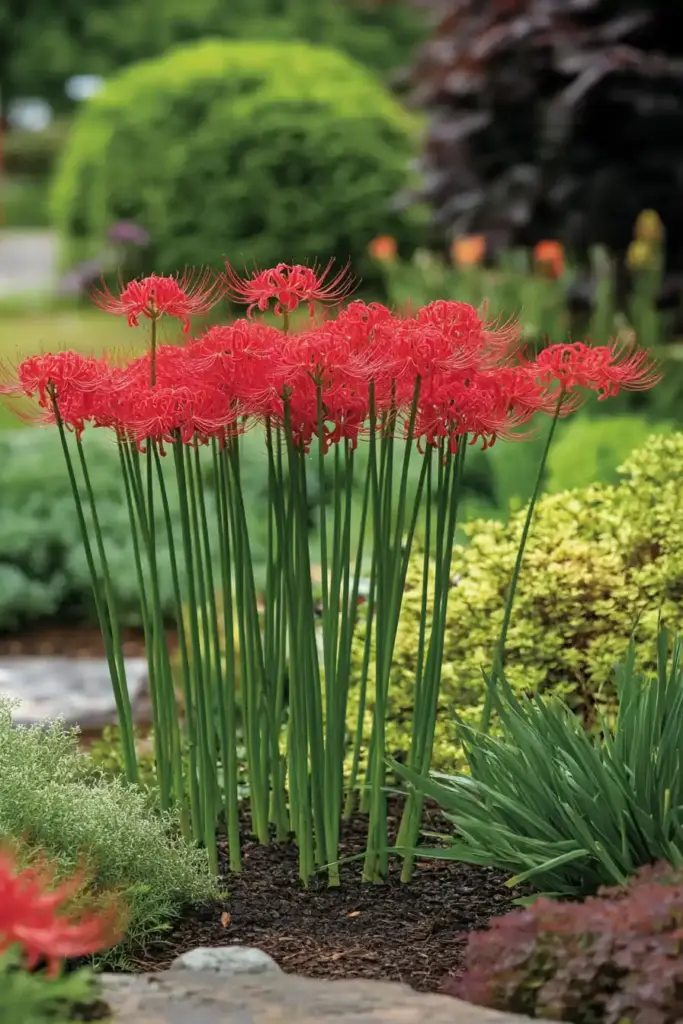
Spider lilies can be propagated by dividing mature bulb clumps—but timing and handling are important, as these bulbs prefer to be left undisturbed.
How to Propagate Spider Lilies
- Wait until after the blooming period to dig up established clumps.
- Carefully lift and separate the bulbs, avoiding damage to their delicate roots.
- Replant the divisions right away, placing them with their necks slightly above the soil surface.
Patience Pays Off
Don’t be surprised if newly transplanted spider lily bulbs don’t bloom for a year or more. These plants are slow to reestablish after being disturbed, and forcing blooms prematurely can stress them.
For best results, avoid frequent digging—just divide every few years when flowering declines or bulbs become overcrowded. With time, they’ll settle in and resume their magical blooming rhythm.
🐛 Pests and Problems
One of the many perks of growing spider lilies is how trouble-free they are. These bulbs are resilient, dependable, and rarely face serious issues.
Common Problems to Watch For
- Root Rot
This is the most common concern and usually happens when bulbs are planted in poorly drained or consistently wet soil. Always ensure drainage is adequate, especially during dormant periods. - Lack of Blooming
If your spider lilies aren’t flowering, the most likely culprits are:- Too much shade – these plants need sun to trigger blooming.
- Improper planting depth – if the bulb’s neck is buried too deeply, it may not flower.
- Overcrowding – bulbs need space; divide clumps every few years if bloom quality declines.
Pest Resistance
Spider lilies are naturally pest- and disease-resistant, which means:
- No regular spraying or chemical treatments required.
- Deer and rabbits tend to avoid them, making them perfect for gardens with wildlife visitors.
- Their nectar-rich blooms attract bees, butterflies, and hummingbirds, adding pollinator value to your landscape.
🌼 Recommended Varieties of Spider Lily
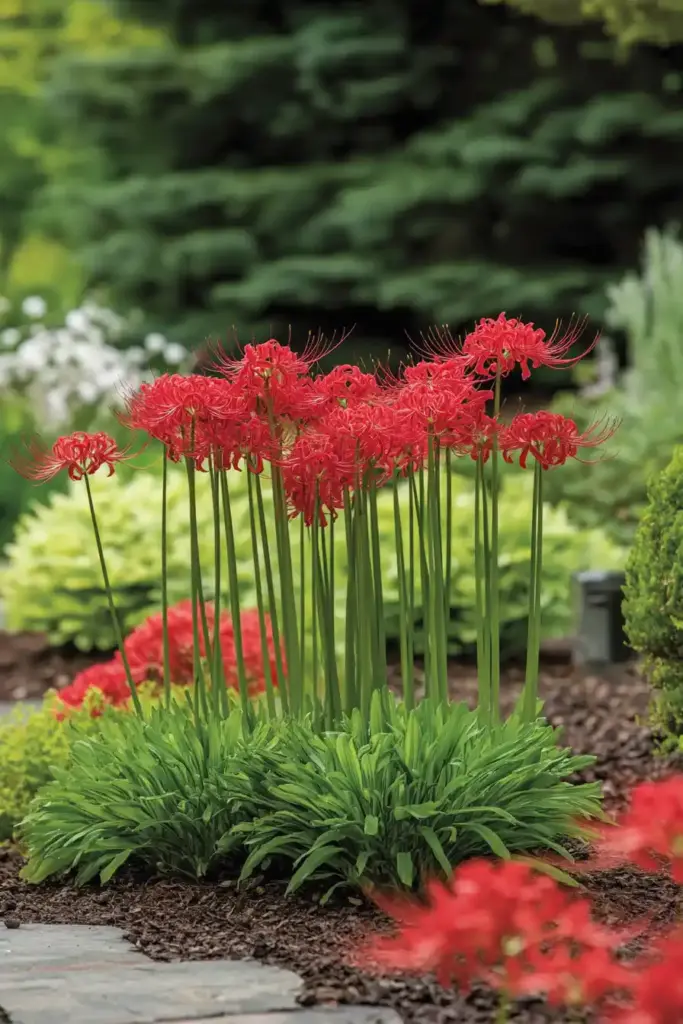
Spider lilies (Lycoris species) come in several striking varieties, each offering its own unique shape, color, and growing habit. Here are a few favorites to consider adding to your garden:
🔴 Red Spider Lily (Lycoris radiata)
- Appearance: Vibrant coral-red blooms with dramatically long, curling stamens.
- Height: Up to 24 inches tall.
- Climate Preference: Thrives in warm, humid regions—especially popular in the Southern U.S.
- Best Uses: Perfect for heirloom gardens, borders, and partial-shade beds.
This is the classic “hurricane lily” seen popping up in old Southern gardens and cemeteries, known for its reliability and rich history.
⚪ White Spider Lily (Lycoris albiflora)
- Appearance: Clusters of 6–8 white flowers, often featuring a subtle creamy-pink stripe.
- Special Feature: Excellent as a cut flower thanks to its elegant form and long vase life.
- Light Needs: Prefers partial shade to protect its delicate blooms.
💗 Naked Ladies (Lycoris squamigera)
- Appearance: Trumpet-shaped lilac-pink blooms atop bare stems.
- Foliage Cycle: Spring foliage dies back in summer before the flowers emerge.
- Height: Grows up to 18 inches tall.
- Use: A show-stopping late-summer surprise, often used in naturalized gardens.
Each of these varieties adds a unique twist to the late-season garden, ensuring bursts of color and charm when other plants have finished their show.
🌳 Garden Uses
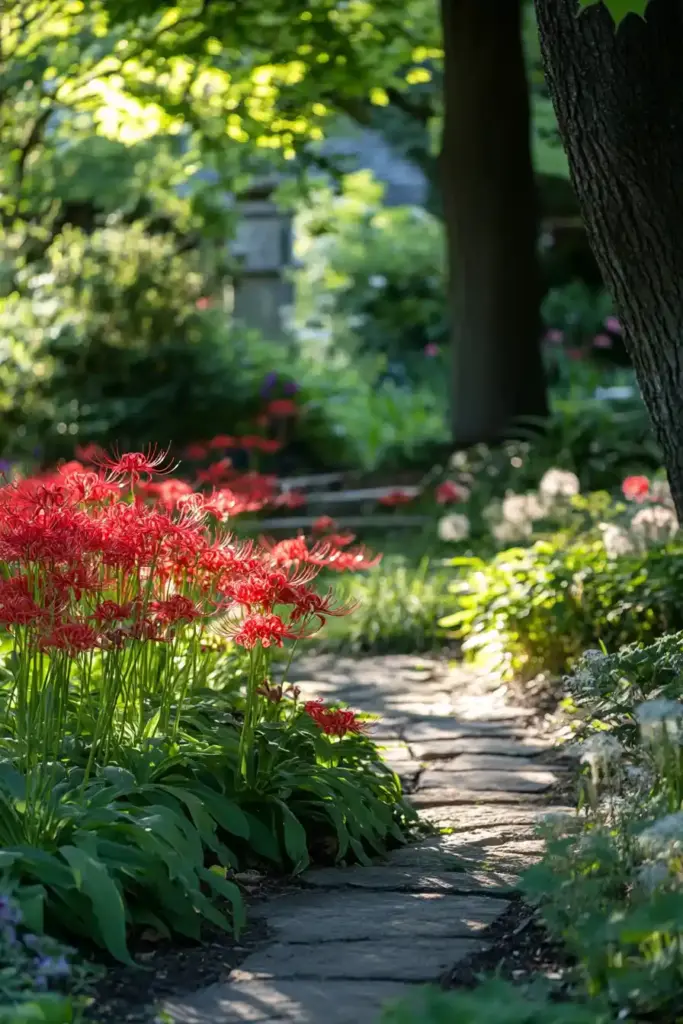
Spider lilies are not only beautiful but also versatile, lending themselves to a wide range of garden styles and landscape designs. Whether you’re working with borders, pathways, woodland edges, or containers, these bulbs are ready to impress.
🌸 Where and How to Use Spider Lilies in Your Garden
- Mass Plantings: For a dramatic effect, plant spider lilies in large clusters along perennial borders or in shrub beds. Their sudden, synchronized blooming creates a stunning visual.
- Pathway Accents: Line partially shaded garden paths with these elegant flowers. Their tall, leafless stems and spidery blooms make a whimsical, almost surreal display.
- Naturalizing Spaces: Ideal for woodland edges or transition zones between lawn and forest, spider lilies can naturalize over time, filling in gaps with low effort.
- Foliage Pairing: Combine spider lilies with lush foliage plants like hostas or ferns. The contrast of bold leaves and delicate blooms enhances visual texture.
- Seasonal Layering: Mix them with spring-flowering bulbs (like daffodils or tulips) to ensure multi-seasonal interest in the same bed.
🌿 Container Gardening and Floral Use
- Container Arrangements: If you live outside USDA zones 7–11, grow spider lilies in containers that can be moved indoors during cold months.
- Use them as the “thriller” in container designs, anchoring the arrangement with bold height and structure.
- Cut Flower Gardens: Their unique shape and sturdy stems make spider lilies a fantastic choice for bouquets. Plant extras in a dedicated cutting garden for fresh indoor displays.
These adaptable plants bring late-season magic wherever they grow, and their many uses make them a valuable asset for gardens big and small.
✅ Conclusion
Spider lilies are truly a hidden gem in the gardening world—graceful, low-maintenance, and full of surprise. Whether you’re planting them in borders, naturalizing a woodland edge, or showcasing them in containers, these enchanting bulbs reward patience with sudden, show-stopping blooms that captivate both gardeners and pollinators alike.
By choosing the right variety, planting at the right depth, and giving them a sunny spot with good drainage, you’ll enjoy years of vibrant late-summer displays with minimal effort. They’re not just beautiful—they’re resilient, versatile, and perfect for any gardener looking to add a little magic to the landscape.
🙋♀️ Frequently Asked Questions About Spider Lilies
1. When is the best time to plant spider lily bulbs?
The ideal time to plant spider lily bulbs is in fall or early spring. This gives the bulbs time to settle and prepare for their surprise bloom after late-summer rains.
2. Do spider lilies come back every year?
Yes! Spider lilies are perennial bulbs that return annually with proper care. They often naturalize over time, creating larger clusters year after year.
3. How long do spider lilies bloom?
Spider lily blooms typically last around two weeks, appearing suddenly in late summer or early fall and vanishing just as quickly.
4. Can spider lilies grow in containers?
Absolutely. Spider lilies can thrive in containers, especially in colder zones outside USDA 7–11. Just be sure to bring the pots indoors during freezing weather.
5. Why aren’t my spider lilies blooming?
Common reasons include:
- Too much shade
- Bulbs buried too deep
- Overwatering during dormancy
- Overcrowded bulbs needing division
Ensure full sun to partial shade, plant with necks above the soil, and allow a dry dormant period in summer.
6. Are spider lilies toxic to pets?
Yes. Like many bulbs in the amaryllis family, spider lilies can be toxic to cats, dogs, and other pets if ingested. Plant them in pet-safe zones.
7. Do deer eat spider lilies?
No—spider lilies are deer-resistant, making them an excellent choice for gardens plagued by browsing wildlife.

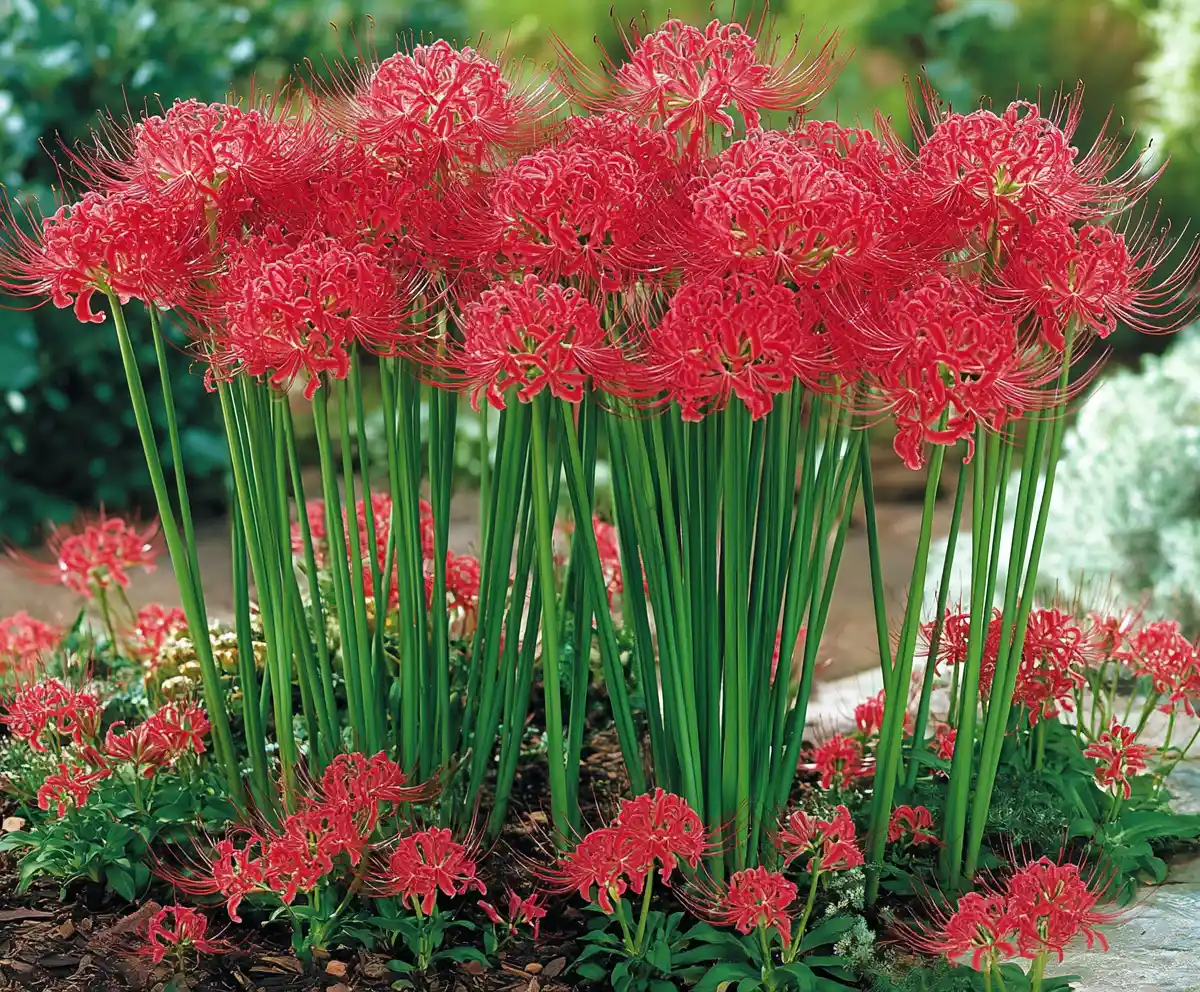
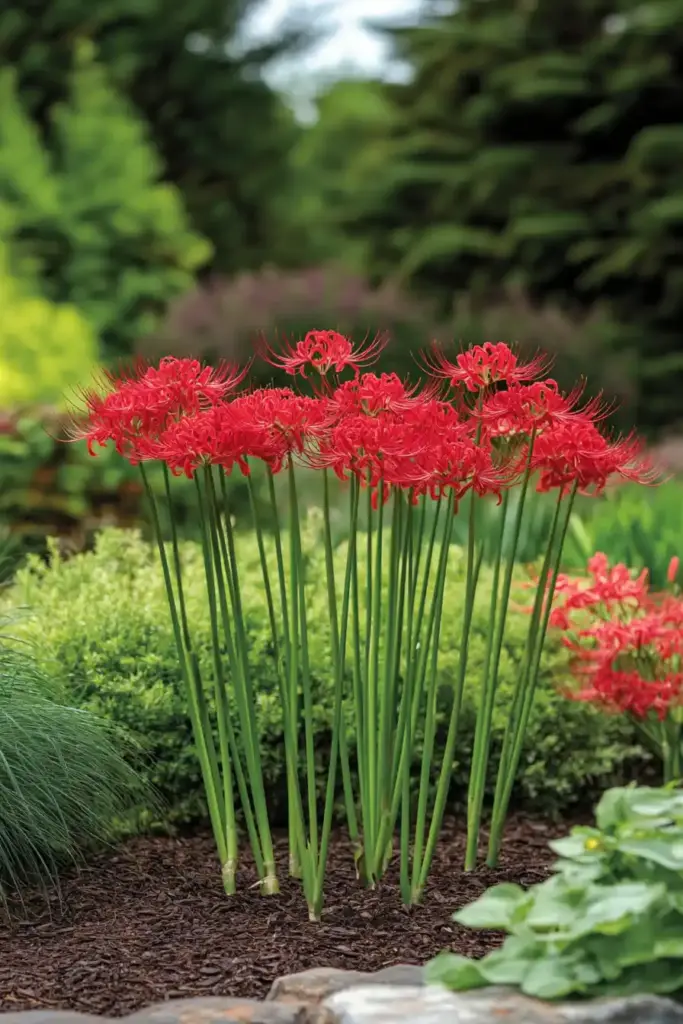
I absolutely love the golden lycoris! I only have the golden. Southern Bulb out of Tyler, Tx is where I order mine from. Quality bulbs.